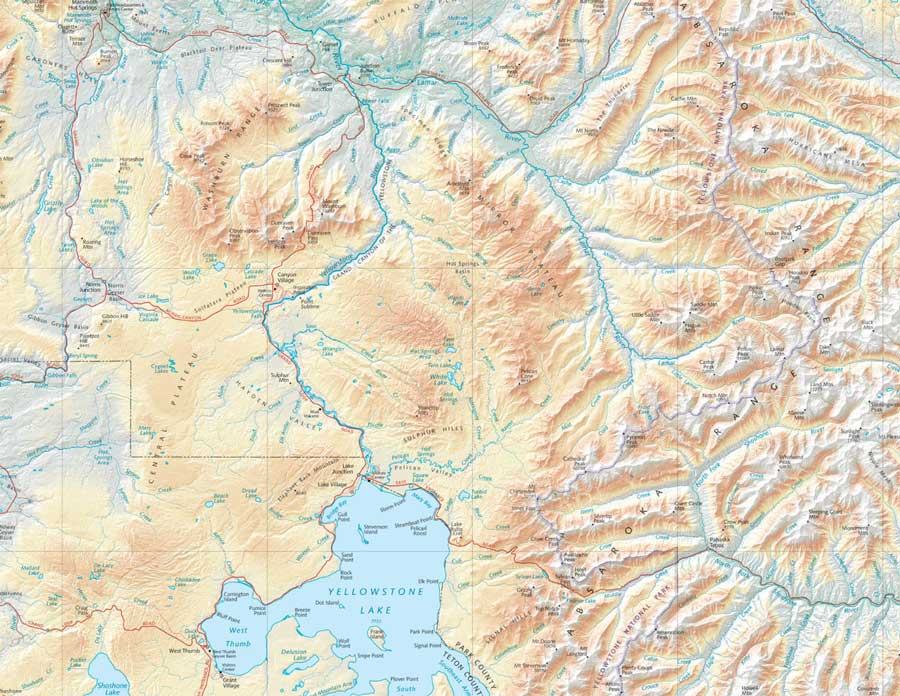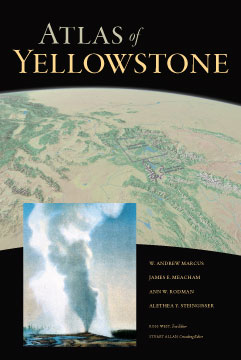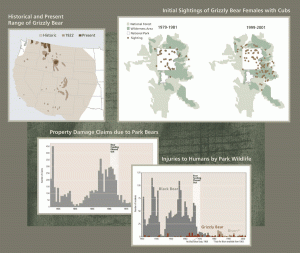
The newly released Atlas of Yellowstone includes more than 800 maps, along with charts, illustrations and graphs offering a comprehensive view of the Yellowstone region. (University of California Press - click to enlarge)
By Ruffin Prevost
CODY, WYO. — The editors of a comprehensive and authoritative new reference book about the greater Yellowstone area are visiting gateway communities this month to discuss their nearly decade-long effort to create The Atlas of Yellowstone.
“I learned so much making this Atlas,” said Ann Rodman, who has worked in Yellowstone National Park since 1988.

Atlas of Yellowstone
Rodman and her fellow Atlas of Yellowstone editors spoke about the project Thursday at the Buffalo Bill Historical Center in Cody, Wyo. They will speak Tuesday in Grand Teton National Park.
“For me, this was a great, fun process,” Rodman said before pausing, and then adding with a smile, “most of the time.”
It wasn’t always fun because Rodman, Yellowstone’s top geographic information system specialist, was among those responsible for gathering, compiling and reviewing data from more than 130 specialists and experts for the 300-page book that contains more than 800 maps accompanied by data-laden illustrations covering hundreds of major topics. The work was fun, but enforcing deadlines on distracted researchers wasn’t.
But after 24 years working in Yellowstone, Rodman said she was amazed how many new things she learned — or gained a fresh perspective on — while working on the project.
She cited two pages from the book prepared in collaboration with Charles Preston, curator of the Draper Museum of Natural History at the BBHC. That section focuses on sagebrush-steppe habitat and its role in sustaining the greater sage-grouse, which is largely absent from Yellowstone because of the park’s higher elevation.

The historic range of grizzly bears, bear injuries in Yellowstone Park and where bears are seen by people are just some of the ways The Atlas of Yellowstone tells the story of grizzly bears in the park. (University of California Press - click to enlarge)
“It made me open my eyes to how much I wasn’t paying attention to what’s going on outside the park,” Rodman said, noting that it’s easy for researchers to work in a “bubble” of their own special interest.
Tying together those seemingly disparate specialized topics to tell the story of Yellowstone and Grand Teton national parks was a central goal of the book, said senior editor Andrew Marcus.
“Yellowstone Park is not a zoo,” Marcus said. “It’s something that’s profoundly connected with the surrounding region.”
So the team worked to tell stories that reinforced major themes throughout the book, rather than just compiling factoids, he said, creating a “continuity of geographic vision across the entire region.”
Another goal of the book was to make scientific data more accessible and user-friendly for everyday readers, said cartographic editor Jim Meacham.
The Atlas of Yellowstone editors will sign and discuss their book, including the history of mountain climbing in the Tetons, at 5:30 p.m. Tuesday, July 17 at the Craig Thomas Discovery and Visitor Center in Moose, Wyo. Call 307-739-3399 for more information.
That meant a series of brainstorming sessions with top experts in dozens of specialized fields to discover the best way to tell compelling stories about key issues using maps and charts, he said. Condensing complex information on major topics like grizzly bears or park visitation to fit on a two-page spread was a creative challenge.
The end result is a book that liberates forgotten or overlooked data from spreadsheets, scientific journals, government reports and filing cabinets and presents them in beautiful, informative and inspiring ways to tell a rich and detailed story about hundreds of aspects of Yellowstone.
The Atlas of Yellowstone is available online and in bookstores. Just don’t ask when the digital version will be ready. After nine years toiling on the paper version, the editorial team is first focusing on a more pressing matter — selling the book.
Contact Ruffin Prevost at 307-213-9818 or ruffin@yellowstonegate.com.

Cracking open a brand-new copy of the Atlas was so exciting – it’s simply beautiful. The professionalism that went into its creation is striking. The cartography takes advantage of all of the modern digital techniques, including advanced shaded relief representations. I’ll have this on my coffee table for many years to come!
Bryan,
If you’ve got some favorite maps of Yellowstone, Grand Teton or the surrounding area you’d like to share, please get in touch. We love maps and want to share them with readers.
-Ruffin Prevost, editor
ruffin@yellowstonegate.com